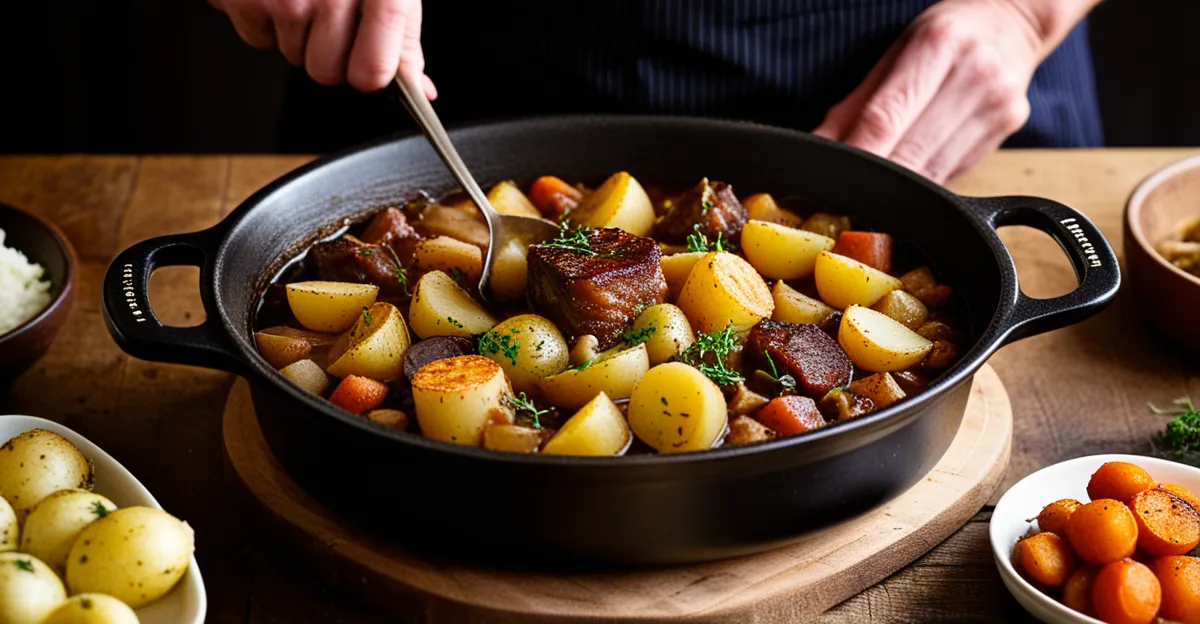Essential Ingredients for Lancashire Hotpot
Knowing the Lancashire hotpot ingredients is key to mastering this iconic British dish. The traditional hotpot recipe is rooted in simplicity and hearty flavours that bring comfort to the table. At the core are traditional cuts of lamb or mutton, prized for their rich taste and tenderness when slow-cooked. These meats provide the foundation that distinguishes Lancashire hotpot from other stews.
Key vegetables include potatoes, onions, and carrots. Potatoes are often sliced thinly and used both within the layers and as the top crust, forming a golden, crispy finish. Onions and carrots contribute sweetness and depth to the stew, balancing the robust meat flavours.
Also read : What Are Innovative Ways to Put a British Twist on Your Favorite Recipes?
Additional flavourings complete the dish: a good quality stock forms the broth base, Worcestershire sauce adds umami complexity, and herbs such as thyme or bay leaves infuse subtle aromatic notes. Each ingredient plays a specific role, ensuring the classic British ingredients work harmoniously. Understanding these essentials supports both authenticity and culinary success in your hotpot preparation.
Preparatory Steps: Getting Ready to Cook
Prepping ingredients is crucial for an authentic Lancashire hotpot.
Also to see : How do you make a classic Lancashire hotpot from scratch?
Mastering Lancashire hotpot preparation begins with meticulous prepping ingredients to maximize flavour and texture. Slicing potatoes thinly ensures they cook evenly and create the dish’s signature golden crust. Onions and carrots should be chopped or sliced uniformly to blend seamlessly with the meat layers.
An essential step is browning the lamb or mutton before assembling the hotpot. This caramelises the meat’s surface, enhancing depth and richness in the final stew—key to a successful traditional hotpot recipe. Browning also helps lock in juices, preventing the meat from becoming dry during the slow cooking process.
Choosing the right cooking vessel plays a role too. Many cooks prefer a heavy casserole dish or slow cooker, which provides even heat distribution and retains moisture—perfect for the long cooking times Lancashire hotpot demands. Prepping your cookware, whether greasing it lightly or preheating, sets the stage for a visually appealing and sumptuous dish with classic British ingredients.
Strong preparation guarantees each layer—from tender meat to delicate vegetables—harmonises flawlessly when cooking Lancashire hotpot.
Step-by-Step Cooking Instructions
Cooking Lancashire hotpot is about layering and timing with precision. The classic Lancashire hotpot method starts by evenly layering browned lamb or mutton with thinly sliced potatoes, onions, and carrots inside your casserole dish or slow cooker. This layering ensures each bite offers a harmonious blend of classic British ingredients.
The meat goes first, creating a rich base that infuses the vegetables above. Potatoes form a final top layer, which crisps to the dish’s signature golden crust during cooking. For even cooking, maintain a low temperature—typically around 150-160°C (300-320°F)—and let the hotpot cook slowly for 2-3 hours. This slow simmer allows flavors to meld and meat to become tender.
During cooking, check the liquid level to keep the broth from drying out; adding stock if needed sustains moisture and depth, vital for the traditional hotpot recipe. Avoid opening the lid too often, as this lets heat escape and could interrupt cooking. By following these precise steps, you ensure the perfect Lancashire hotpot—rich, tender, and with that irresistible crispy potato crown.
Tips for Authentic Flavor and Texture
Achieving an authentic Lancashire hotpot hinges on a few strategic choices. Selecting the right cut of lamb or mutton is vital—shoulder or neck cuts work best because they become tender through slow cooking, perfectly aligning with the traditional hotpot recipe.
Enhancing the broth’s flavour is equally critical. Use a rich stock as the base, and balance it with Worcestershire sauce for umami depth. Fresh herbs like thyme and bay leaves should be added early, allowing their aromas to infuse throughout the cooking process. Maintaining proper liquid ratios prevents dry meat or diluted flavours, a common pitfall in Lancashire hotpot preparation.
To avoid soggy potatoes, ensure they are sliced thinly but not too thick, and position them correctly—thin layering helps crisp the top. Don’t underestimate seasoning: salt and pepper must be judiciously applied at each stage to build well-rounded taste. Avoid opening the lid frequently, which can affect cooking temperature and texture.
Following these traditional cooking tips guarantees your hotpot showcases the full potential of classic British ingredients with a tender, flavoursome bite and that distinctive golden crust.
Serving Suggestions and Accompaniments
Complementing Lancashire hotpot with the right sides enhances its hearty profile and celebrates its roots in classic British ingredients. Traditional accompaniments like pickled red cabbage provide a tangy contrast, cutting through the richness of the slow-cooked lamb or mutton. The acidity brightens the palate and refreshes the taste buds after each savory bite.
Crusty bread is another essential serving suggestion, perfect for soaking up the flavorful broth that defines the traditional hotpot recipe. Warm, freshly baked bread invites diners to enjoy every last drop, making the meal more satisfying and complete.
For those wondering how to serve Lancashire hotpot to guests or family, presentation in the original casserole dish adds rustic charm and encourages sharing. Pairing the dish with simple, seasonal vegetables or a light green salad balances the meal nutritionally and visually.
Leftovers remain delicious and can be reheated gently on the stove or in the oven. This keeps the signature golden crust intact without drying out the tender layers below. These hotpot sides and serving tips respect the dish’s heritage while making it easy to enjoy time and again.
The Tradition and History Behind Lancashire Hotpot
Lancashire hotpot traces its origins to the industrial heartlands of Northwest England, where it became a staple for working-class families needing nourishing, economical meals. Its creation reflects British food traditions centered on using readily available, affordable classic British ingredients—such as lamb or mutton and root vegetables. This simplicity made it ideal for sustaining laborers through long, demanding days.
As a symbol of regional UK cuisine, Lancashire hotpot embodies comfort and communal dining. The slow cooking method allowed tougher meat cuts to become tender, making it accessible and deeply satisfying. Over time, the dish evolved, with traditional hotpot recipe variations incorporating local herbs or seasoning tweaks while preserving the core elements.
This history highlights not just a dish but a cultural narrative—where resourcefulness and flavour combine to create a culinary icon representative of Lancashire’s heritage. Lancashire hotpot continues to be celebrated for its rustic charm and hearty profile, linking past traditions with modern tables. Understanding this backdrop enriches appreciation and informs authentic preparation within the broader scope of British cooking.








